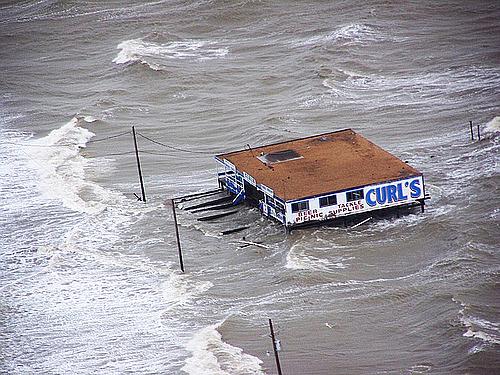Stormy Weather and Rising Sea Levels

Storm surge of Hurricane Ike near Galveston, TX (U.S. Air Force photo/Master Sgt. Wally Bacio)
Hurricane Katrina did more than just flatten New Orleans. It also triggered the unprecedented collapse of the public health system in a modern American city, shuttering 13 of 16 acute care hospitals, including Charity and University Hospitals, two fabled public facilities that had long served the poor. Katrina wrought serious shortages of hospital beds, laboratory facilities, equipment, supplies, and crucial staff, from nurses and doctors to specialists like anesthesiologists. Thousands of doctors were displaced, causing virtually all residents to lose access to their normal health care providers. For many months afterwards, one doctor noted, “health care remained unacceptably primitive.”
Seven years later, when Superstorm Sandy hit New York, a similar scenario played out in parts of the city. Backup generators failed at two major hospitals -- NYU Langone Medical Center and Bellevue, -- forcing hundreds of patients to evacuate. Once the storm subsided, thousands of public health nurses deployed to meet the need of tens of thousands of chronically ill patients who were stranded in high rises with no heat, electricity or elevator services. In some of the hardest hit communities, like Far Rockaway and Breezy Point, homes were shattered or left without running water or power, doctors were flooded out, and pharmacies were closed, cutting off sickly residents from medical care. Going a week without proper medication can be catastrophic for frail people suffering from diabetes, asthma, or high blood pressure.
While New York City’s overall emergency response to Sandy was impressive, a disaster of this magnitude revealed the fissures and critical deficiencies in the public health system, especially for our most vulnerable citizens. What happened there and in New Orleans underscores the shattering impact of extreme weather events to the health care system, and what we potentially face as the planet gets warmer.
While climate change didn’t necessarily cause Hurricane Sandy, it certainly made it worse, because the massive swell of water that washed over land by Sandy caused much of the damage -- demolishing beaches, filling subway tunnels, swamping boardwalks and destroying the electrical infrastructure. In the past 100 years, sea levels have risen anywhere from 10 to 15 inches in the East Coast. About half of that rise can be attributed to natural causes, when land settles, but climate scientists estimate that global warming is responsible for at least eight inches of Sandy’s storm surge.
Hurricanes pose a tremendous threat to our coastal cities, which are home to nearly half the nation’s population—about 153 million people, according to the National Oceanic and Atmospheric Administration, a figure that is expected to reach 165 million by 2015. The majority live in regions vulnerable to storms like Katrina or Sandy, along the Atlantic and Gulf coasts, a report by the National Academy of Sciences reveals. This greatly increases the potential of hurricanes to cause “catastrophic loss of life and property damage.” Some scientists expect sea level to rise from two to seven more feet by the end of this century, further compounding these risks.
As the mercury continues to climb, the intensity and frequency of hurricanes has been the subject of intense debate within scientific circles. With increasing temperatures and sea level rise, more moisture evaporates into the air. Heightened moisture and energy in the atmosphere, coupled with warmer oceans, translates into more powerful hurricanes (ocean water must remain above 82 degrees Fahrenheit for hurricanes to form). But there was a tiny silver lining embedded in scientists’ calculations: the consensus was that although storms were predicted to be stronger, climate models indicated they wouldn’t happen as often.
But new research challenges that assumption. A study earlier this year from an international group of scientists, which used a new method of calculating hurricane power and frequency, concluded that when ocean temperatures were higher, big hurricanes like Katrina were twice as likely to form. The scientists also surmised that storms would be more dangerous because they were accompanied by the large storm surges, like the one that swamped lower Manhattan and Brooklyn. And now research by an MIT climatologist that uses even more sophisticated computer modeling techniques indicates hurricanes will be stronger and hit more often. By 2100, MIT research estimates that tropical cyclones will increase by 10% to 40%, intensity will rise by 45%, and the number of storms that make landfall—which, by definition, do the most damage—will jump by 55%. In other words, we need to prepare and can use the successes and failures of public health systems in New Orleans and New York to form a roadmap for getting ready. I will address that in my blog next week.
Linda Marsa's book FEVERED will be available on August 6, 2013, wherever books and e-books are sold.
Image from Chuck Simmins via Flickr.

